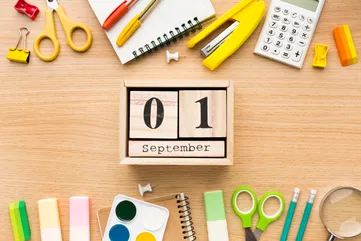
I've lost count of the number of times I've set myself lofty goals that I gave up on or failed to achieve. I've even signed up for a marathon that came and passed with my running shoes barely leaving their spot in the closet. 'Life got in the way', 'Work is just too busy right now,' 'I'll try again next year' -- the excuses I found were creative. They did, however, hold some truth. My goal was perhaps a little too challenging and my attempts to achieve it did not take my work schedule into account.
How to Set Goals for Kids
Research into goal-setting has suggested that there is a right and a wrong way to go about setting goals. By improving the way we set our goals and the systems we put in place to achieve them, we can increase our chances of actually succeeding. These are the very principles we use at Coachbit. By building a specialized curriculum, we help students create sustainable systems to meet their goals.
Dr. Edwin Locke, Dean's Professor Emeritus of Leadership and Motivation at the University of Maryland, is a pioneer in the study of motivation and goal-setting theory. Locke's early research suggested that 90% of the time people worked harder toward goals that were specific and appropriately challenging.
Years later, Locke collaborated with Dr. Gary Latham, the Secretary of State Professor of Organizational Effectiveness at the University of Toronto. The two published _A Theory of Goal Setting and Task Performance _ which outlined five principles for effective goal setting.
Latham and Locke's principles form the core of our curriculum and we hope by understanding the process, you can better support your child or even set out to achieve a few goals of your own alongside them.
Goal Setting Principles for Kids
Principle 1: Set Clear Goals
The clearer and more specific a goal is, the easier it is to measure results and achieve. Abstract and vague goals such as 'I want to improve my grades' or 'be better at school' are almost impossible to measure.
Without the ability to measure progress, it is difficult to remain motivated. That's why, when students aim to improve their academic results, we encourage them to specify a grade - 'I want to achieve an A in my upcoming test.'
If you'd like to do the same, a good starting point is to write your goal down in the most specific and detailed way you can. The SMART method is a great way to make sure goals are clear. This can be used in addition to Locke and Latham's principles. Your goal should be Specific, Measurable, Achievable, Relevant, and Time-bound.
Principle 2: Set Challenging Goals
There is a fine line between setting a goal that is 'too challenging' and 'challenging enough'. As Locke's initial research suggested, a goal needs to be sufficiently challenging to be motivating. A goal should be realistic and attainable, but unless it requires some effort to get there, you will feel very little sense of accomplishment once you've achieved it. Too challenging and you'll give up easily, not challenging enough and you'll likely lose interest.
When our student's set goals, we make sure the goal is both ambitious and realistic. It is important that students understand the preparation and work that will need to go into achieving the goal. If a student wants to improve their math grade from a C to an A, it is better to set smaller and more achievable targets to get them to their final goal. Aiming to improve from a C to a B or C+ is more realistic.
Jon Acuff, New York Times Bestselling Author of Finish: Give Yourself the Gift of Done, suggests halving your goal in order to make it more attainable. In his '30 Days of Hustle' program he reported that after halving their goal, participants' performance improved by 63% and 90% reported that they felt more motivated. Acuff suggests starting small and adjusting the effort level as you begin to achieve the smaller goals.
Principle 3: Commit to your Goals
Goals require commitment and dedication. Before a goal is set you need to fully understand what will be expected of you and then buy into the process. Locke and Latham maintain that one has to commit to both the content and the intensity of a goal. Content refers to the process of achieving the goal (not just the outcome) and intensity refers to the mental and physical requirements necessary to do so. If you want to learn a new language, you'll have to commit to regular lessons during the week and ensure it fits into your existing schedule.
Including a personal mission statement or a 'why' is also a great way to spark the motivation and commitment necessary to achieve a goal - 'I want to save money to ensure a better future for myself' or 'I want to exercise daily to improve my health and wellbeing.'
Principle 4: Give Feedback on your Goals
Most people give up on a goal when it becomes boring, too difficult or when they fail to follow the plan they had set out. Acuff argues that the biggest obstacle to achieving our goals is perfectionism. When we are unable to follow our eating plan for a day, we decide to forgo the plan for the week and try again the next week - which rarely happens.
Acuff calls this 'the day after perfect' and it's the make or break for any goal. It's what we choose to do after we have missed our jog or devoured a slab of chocolate in one sitting.
This is why feedback is important. Our ability to pause, reflect, adjust our course, or adjust our goal, is the deciding factor on whether we are able to achieve our goals. Our coaches make sure to set aside time with their students to help them reflect on and monitor their progress. This is linked to the concept of metacognition which involves planning, monitoring and evaluating our learning.
These are some of the questions we prompt our students to consider:
- What is getting in the way of achieving your goal?
- Does your goal need to be adjusted?
- Can your goal be broken down into more manageable chunks?
- Do you predict any future challenges?
- How do you feel about your goal?
The answers to these questions should guide any changes they make going forward.
Principle 5: Consider the Complexity of your Goals
Much like the effort level of the goal, the complexity of a goal can be another setback in achieving our goals. Should a task be too complex, and we aren't prepared for it, we are likely to give up completely. If a single broad goal is set for a highly complex task, it's probably ineffective. A better way to go about it would be to divide the broader goal into smaller, more comprehensible chunks.
For a student who wants to get in touch with their creativity, 'write a book' is far too broad and daunting. A better way to start would be to 'write five pages this week' or 'brainstorm a chapter'.
Spend time thinking about your goals, researching the steps you need to put in place to achieve them, and planning accordingly.
James Clear, the author of Atomic Habits, warns us not to focus too much on the goal itself at the risk of not prioritizing the habits and systems needed to achieve it. He writes: 'You do not rise to the level of your goals. You fall to the level of your systems.' If your goal is to run a marathon, your system would be your monthly training schedule.
Whether a system or a goal is more important is a debate for another day, but at Coachbit we recognize the importance of both. Without focusing on the habits and routines that make up our day, we have little hope of achieving the goals we have set out for ourselves. We are all about setting our students up for success.
A Final Thought
Our lives are full of goals of different kinds and sizes but at the end of the day, we at Coachbit believe that it all comes down to our 'why'. Before we begin helping our students set out their goals, we ask them to reflect and create an identity board. This allows them to decide the person they want to be and the motivation behind their goals. Do they want to make the football team because they want to prioritize their health and fitness or because they plan to play professionally one day? When motivation is low, and progress is slow -- because it can be -- our why is what keeps us going.
Recommended Resources:
Jon Acuff, Finish: Give Yourself the Gift of Done
James Clear, Atomic Habits
Gary Latham and Edwin Locke, A Theory of Goal Setting & Task Performance
James Clear, 'Goal Setting: A Scientific Guide to Setting and Achieving Goals.'
Watch: Change your Brain: Rich Roll Podcast with Neuroscientist Dr Andrew Huberman.
How many core habits and skills is your child missing?
Take our short quiz and find out.
Take our quiz
_2AwTJ.webp)
